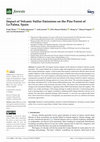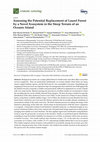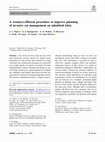Papers by Félix Manuel Medina

Journal for Nature Conservation, 2016
Removal of feral cats from island environments is useful mechanism by which their ecological impa... more Removal of feral cats from island environments is useful mechanism by which their ecological impact on endangered species can be reduced or ended. Nevertheless, because cats are anthropogenic in their origins, social perceptions of management practices play a large role in their implementation. Four-hundred questionnaires were delivered (386 were returned) with 100 going to each of the following: local residents, environmental workers, tourists, and hunters. Questions explored respondents' knowledge about island biodiversity and invasive species as well as attitudes towards cat population management methods. Habitat destruction and introduction of invasive species were considered the main threats for the conservation of island biodiversity. Most respondents considered cats to have a negative impact on biodiversity and sterilization campaigns were considered most appropriate for cat population control. Several free sterilization campaigns have been conducted in La Palma Island Biosphere Reserve in order to reduce free-ranging cats and were well received by local people. This research, which combined concepts of management, ecology and social sciences, provides valuable insights which may to be applicable on other several islands where cats and people are present and in conflict with conservation priorities.

Forests, 2022
In autumn 2021, the largest volcanic eruption on the island of La Palma in historic records took ... more In autumn 2021, the largest volcanic eruption on the island of La Palma in historic records took place. The Canary Islands are of volcanic origin and eruptions have always constituted part of their natural disturbance regime. Until recently, their impacts could not be directly observed and studied. Influence of the emission of phytotoxic gases on biodiversity and ecosystem dynamics was hitherto unknown. The recent eruption is still being intensely monitored. We used Sentinel-2 remote sensing data to analyze the spatial extent and intensity of the impact related to sulfuric emissions, aiming to understand the damage patterns in Canary pine forest. The emissions damaged 10% of that forest and affected 5.3% of the Natura 2000 protected areas. We concluded that this is largely due to the toxic effects of the enormous emissions of SO2. We found a clear correlation between the change in the normalized difference vegetation index (NDVI) and distance from the eruption. This pattern was weak...

La introduccion de especies exoticas es la mayor amenaza para la biota y los ecosistemas en islas... more La introduccion de especies exoticas es la mayor amenaza para la biota y los ecosistemas en islas, por delante incluso de la destruccion y alteracion del habitat, considerado el principal factor de perdida de biodiversidad a nivel mundial. Una de las especies introducidas que mas impacto ha causado en la conservacion de la fauna nativa en islas de todo el mundo es el gato cimarron. Son unos depredadores generalistas y oportunistas y se alimentan de una amplia variedad de presas, incluyendo especies insulares endemicas y amenazadas. El archipielago canario es uno de las areas insulares del mundo donde la dieta de este depredador ha sido estudiada en mayor profundidad. Sin embargo, existen algunos vacios de informacion relativos a la ecologia trofica en islas oceanicas de ambientes heterogeneos y semiaridos presentes en Canarias, asi como sobre la amenaza sobre las poblaciones de invertebrados endemicos. Ademas, y una vez completados esos vacios de informacion sobre la dieta, era nece...

Remote Sensing, 2020
Biological invasions are a major global threat to biodiversity and often affect ecosystem service... more Biological invasions are a major global threat to biodiversity and often affect ecosystem services negatively. They are particularly problematic on oceanic islands where there are many narrow-ranged endemic species, and the biota may be very susceptible to invasion. Quantifying and mapping invasion processes are important steps for management and control but are challenging with the limited resources typically available and particularly difficult to implement on oceanic islands with very steep terrain. Remote sensing may provide an excellent solution in circumstances where the invading species can be reliably detected from imagery. We here develop a method to map the distribution of the alien chestnut (Castanea sativa Mill.) on the island of La Palma (Canary Islands, Spain), using freely available satellite images. On La Palma, the chestnut invasion threatens the iconic laurel forest, which has survived since the Tertiary period in the favourable climatic conditions of mountainous i...

Rabbits are invasive to the Canary Islands, where they were introduced 500 years ago, during the ... more Rabbits are invasive to the Canary Islands, where they were introduced 500 years ago, during the conquest, from mainland Spain. Nowadays, they occupy all islands, almost all islets, and all the habitats of the archipelago. Rabbit negative impacts are manifested at different ecological levels, from affecting species population, to disrupt native networks of interactions, or to even cause the complete alteration of the structure of the ecosystem. Current ongoing researches in various ecosystems are very concluding: we are far from knowing how would be the natural looking of the ecosystems of the islands, and today we only see what is left after 500 years of herbivorous pressure. It is urgent to raise awareness of this serious problem to subsequently implement appropriate conservation measures to control and minimize the effects that rabbits are provoking to the incomparable and unique ecosystems of the Canary Islands.

Plant Ecology, 2020
Mapping the distribution of invasive 12 species under current and future climate conditions 13 is... more Mapping the distribution of invasive 12 species under current and future climate conditions 13 is crucial to implement sustainable and effective 14 conservation strategies. Several studies showed how 15 invasive species may benefit from climate change 16 fostering their invasion rate and, consequently, affect-17 ing the native species community. In the Canary 18 Islands and on Tenerife in particular, previous 19 research mostly focused on climate change impacts 20 on the native communities, whereas less attention has been paid on alien species distribution under climate change scenarios. In this study, we modelled the habitat distribution of Pennisetum setaceum, one of the most invasive alien species on Tenerife. In addition, we described the species' potential distribution shift in the light of two climate change scenarios (RCP2.6, RCP8.5), highlighting the areas that should be prioritized during management and eradication programs. P. setaceum's suitable areas are located in the coastal area, with higher habitat suitability near cities and below 800 m asl. In both future climate change scenarios, the geographic distribution of P.
Anales del Jardín Botánico de Madrid, 2015
A study on distribution and population size of Androcymbium hierrense (Colchicaceae) an endangere... more A study on distribution and population size of Androcymbium hierrense (Colchicaceae) an endangered taxon, in La Palma Biosphere Reserve (Canary Islands)
Makaronesia: Boletín de la Asociación de Amigos …, 2010
Detalles de las fl ores del picocernícalo (Lotus eremiticus).
Revista de estudios generales de la Isla de La …, 2007
Localización: Revista de estudios generales de la Isla de La Palma, ISSN 1698-014X, Nº. 3, 2007 (... more Localización: Revista de estudios generales de la Isla de La Palma, ISSN 1698-014X, Nº. 3, 2007 (Ejemplar dedicado a: Actas del Primer Congreso-2006-(II)(Arqueología-Arte y Arquitectura-Ciencias-Geografía)), págs. 385-404
Vieraea, 1999
Acceso de usuarios registrados. Acceso de usuarios registrados Usuario Contraseña. ...
Vieraea, 1999
Se estudia la distribución del gato cimarrón (Felis catus) en la isla de Alegranza y la evolución... more Se estudia la distribución del gato cimarrón (Felis catus) en la isla de Alegranza y la evolución de su dieta en los últimos diez años (1987/1997). Los gatos se distribuyeron en todos los hábitats de la isla, siendo La Caldera donde se detectó el mayor número de excrementos (40,9%). ...

Biological Invasions, 2019
Cats (Felis silvestris catus) are one of the most pernicious invasive species on islands, being r... more Cats (Felis silvestris catus) are one of the most pernicious invasive species on islands, being responsible for the decline and extinction of many vertebrate taxa. Eradications programs are a powerful tool to fight against cat impacts on islands, but their implementation requires planning and design to prevent failure. In that sense, gathering data on cat habitat use, abundance and trophic interactions provides key information to effectively design management actions. The present contribution presents a simple resource-efficient methodology using cat feces to assess cat distribution, density and trophic ecology on an inhabited islet. This information is essential in order to effectively organize trapping efforts and minimize subsequent impacts of other species if a control or eradication campaign is undertaken. Additionally, our research effort evaluated the potential influence of coastal and anthropic resources on cat diet, which can also provide useful information for planning aside management actions. Cat distribution on our model islet, La Graciosa, was 'clumped', presenting higher densities in anthropic areas (villages and farms). The invasive house mouse and the European rabbit were the main prey items, although native invertebrates, reptiles and birds were also consumed. Cats on La Graciosa ingested a large quantity of garbage, which was negatively correlated with distance from human J. C. Piquet and E. S. Baumgartner have contributed equally to this work.

Environmental and Sustainability Indicators, 2022
Assessing the environmental status of Protected Areas (PAs) is a challenging issue. To indicate t... more Assessing the environmental status of Protected Areas (PAs) is a challenging issue. To indicate that status, the identification of a common set of variables that are scientifically sound, and easy to assess and monitor by the PA practitioners, is particularly important. In this study, a set of 27 Essential Variables (EVs) for PA management was selected in a bottom-up process from 67 harmonised variables that describe the status of Ecosystem Functions and Structures, Ecosystem Services, and Threats in PAs. This bottom-up process involved 27 internationally recognised PAs, mostly European, with different level of protection, different extent, and a wide range of human-nature interactions. The EVs were selected by more than 120 practitioners, i.e. PA managers and rangers, as well as scientists, working in terrestrial and aquatic PAs. Across both terrestrial and aquatic PAs, scientists and practitioners largely identified the same variables as important. Data availability for these 27 EVs varied between PAs and averaged 67% across all studied PAs. As this set of EVs for PAs is defined through a bottom-up approach considering variables already in use both in management and research, it is more than for previous EVs likely to be adopted, applied and developed to record the status and changes in the ecological and socio-economic conditions of PAs and to forecast future changes. Thereby, the EVs for PAs present a common vocabulary and tool to enhance in a uniform way the (inter)national communication, exchange and comparison of information on the status of PAs between policy makers, scientists and PA managers. The perceived status of the EVs, on an average 3.6 on a scale to a maximum of 5, indicates the surveyed PAs are in a moderate to good environmental condition. Moreover, the EVs for PAs form a cost- and time-efficient tool for PA managers to monitor developments in essential elements of their PAs, including the potential for Societal Goods and Benefits (SG&B), and to (pro-)actively tackle the potential threats that may arise in their area. Likewise, for policy makers EVs for PAs may support decision making on ecosystem management, spatial planning, and predictive modelling on the future status and requirements of PAs in their country or region.
African Journal of Ecology
Galemys, Spanish Journal of Mammalogy
Bird Conservation International, 1996

Uploads
Papers by Félix Manuel Medina